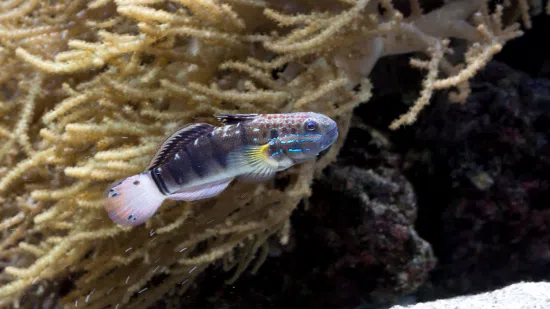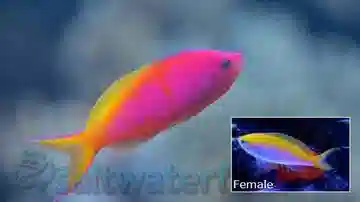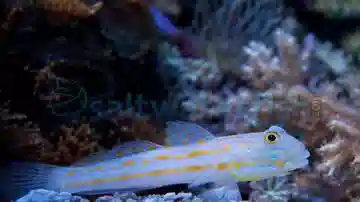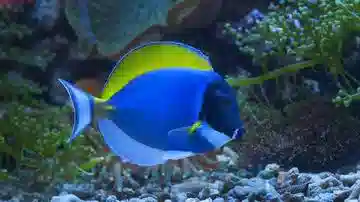Powder Blue Tang
Acanthurus leucosternon
(3 Reviews)

Powder Blue Tang
Acanthurus leucosternon
(3 Reviews)
{{ item.name }}
Size: {{ item.extra_field_3 }}
${{ getFormattedPrice(item.saleprice) }} ${{ getFormattedPrice(item.price) }}
To join the waiting list, click here
Free Shipping
With
$199.00
or more in Marine Life.
More details...
Powder Blue Tang Care Facts
| Care Level: | Moderate |
|---|---|
| Temperament: | Peaceful |
| Diet: | Omnivore |
| Reef Safe: | Yes |
| Minimum Tank Size: | 120 gallons |
| Max Size: | 9 inches |
The Powder Blue Tang, Acanthurus leucosternon, also known as the Powder Blue Surgeonfish, has a disk shaped body, featuring a bright light blue body with a yellow dorsal fin and caudal peduncle, and a darker face outlined in white. Making it a real eye catcher in your aquarium. The Powder Blue Tang also has a scalpel at the base of their tail fin which is very sharp and is used by the Tang for protection from predators, as well as a way of establishing itself with tank mates. Caution should be used when handling Surgeonfish as a cut from its scalpel can cause discoloration and swelling of the skin with a high risk of infection.
The Powder Blue Tang can grow to be about 9" and requires a tank no less than 120 gallons as a fully matured adult. Lush natural algae growth in the tank is suggested in order for the Tang to be able to graze upon in between meals. They may also jump out of an open aquarium, so be sure to have a tightly fitting lid.
Being a peaceful fish in nature, it will get along with most other peaceful tank mates, though it will aggressively defend its territory against other Surgeonfish and Tangs, and is best kept individually.
Introducing the Captivating Powder Blue Tang
Discover the mesmerizing and vibrant addition that is the Powder Blue Tang (Acanthurus leucosternon), prized for its striking appearance and captivating behaviors in saltwater aquariums. This article delves into various aspects of the Powder Blue Tang, including its habitat, reef compatibility, size, lifespan, diet, aquaculture potential, temperament, suitable tank mates, tank requirements, water conditions, other common names, compatible tank mates, and the advantages of sourcing Powder Blue Tangs from Saltwaterfish.com. Learn why this species has earned a special place in the hearts of marine enthusiasts.
Habitat and Distribution:
The Powder Blue Tang is native to the warm waters of the Indo-Pacific region, including the Indian Ocean and the western Pacific Ocean.
Reef Compatibility:
While the Powder Blue Tang is admired for its elegance, it does not pose a major threat in reef environments. It may nip at coraline algae, macro algae and small invertebrates, so make careful consideration when adding it to a reef tank.
Size and Lifespan:
This tang species can grow to a length of approximately 9 to 10 inches (23 to 25 cm). They can have a lifespan of 10 years or more in a well-maintained aquarium with proper care.
Diet:
The Powder Blue Tang is primarily herbivorous, requiring a diet rich in algae and vegetable matter. Providing a variety of high-quality foods, such as seaweed sheets and marine pellets, is essential for their health.
Aquaculture Potential:
Powder Blue Tangs are available in the aquarium trade, and while almost all specimens are wild-caught, aquacultured options are also beginning to be available.
Temperament:
Powder Blue Tangs are known for their active and dynamic behavior. They are territorial and can be aggressive towards other tangs and fish with similar body shapes, making proper tank arrangements necessary.
Suitable Tank Mates:
Wrasse (e.g., Cleaner Wrasse): Peaceful wrasse species can coexist with Powder Blue Tangs, adding diversity to the tank.
Angelfish (e.g., Coral Beauty Angelfish): Some angelfish species with contrasting body shapes can be suitable companions for Powder Blue Tangs.
Cardinalfish (Apogonidae spp.): These small, peaceful fish can create a harmonious tank environment with Powder Blue Tangs.
Hawkfish (e.g., Flame Hawkfish): Hawkfish with different characteristics can cohabitate with Powder Blue Tangs, contributing to a visually dynamic tank.
Damsels (Chromis spp.): Certain damsel species can share the tank with Powder Blue Tangs if introduced cautiously and in proper numbers.
Tank Requirements and Water Conditions:
A spacious aquarium with ample swimming space is essential for the well-being of Powder Blue Tangs. A tank size of at least 120 gallons is recommended to provide room for their active swimming habits. Water quality must be diligently maintained, with stable temperature, salinity, and pH levels.
Why Choose Saltwaterfish.com:
Sourcing Powder Blue Tangs from Saltwaterfish.com offers numerous benefits. Their commitment to ethical and sustainable practices ensures you receive healthy and responsibly sourced specimens. Saltwaterfish.com provides comprehensive information about each species, aiding in well-informed decision-making. With a variety of options, exceptional customer support, and a streamlined purchasing process, Saltwaterfish.com guarantees a smooth and satisfying experience for marine enthusiasts.
In conclusion, the Powder Blue Tang (Acanthurus leucosternon) is a captivating and visually stunning addition to saltwater aquariums. Its vibrant coloration and active behavior make it a valuable and alluring member of marine ecosystems. By providing suitable tank arrangements and selecting compatible tank mates, enthusiasts can enjoy the allure and vibrancy of these captivating tangs in their underwater havens. When considering the acquisition of this remarkable species, choosing Saltwaterfish.com ensures a reliable and ethical source that prioritizes the health and well-being of marine life. The Powder Blue Tang can become a breathtaking and iconic centerpiece in any saltwater aquarium with proper care and attention.
Very nice Powder Blue Tang. Beautiful fish. Very healthy. Swims around constantly in quarantine tank and already eating.
Reviewed by: Rick on Feb. 26, 2018
Beautiful and graceful fish. Acclimated to my tank quickly and is eating algae sheets, brine shrimp, and some flake foods within the first two days.
Reviewed by: Bill on Aug. 8, 2016
This baby is the MOST soothing fish I have, pictures can not do them justice. They swim so elegantly and have the colors of velvet.For that regal look, this is the one you want!
Reviewed by: Joye Cantrell on May 15, 2012















